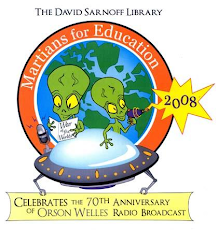 One hundred years ago, a fifteen-year-old immigrant started work as an office boy for the Marconi Wireless Telegraph Company of America, and the world changed because of it.
One hundred years ago, a fifteen-year-old immigrant started work as an office boy for the Marconi Wireless Telegraph Company of America, and the world changed because of it. This June, the David Sarnoff Library will honor its namesake with three illustrated lectures and two exhibits on Sarnoff’s career and New Jersey innovations that changed the world. The lectures take place in Sarnoff Corporation’s Auditorium on successive Tuesday evenings on the 6th, 13th, and 20th of June, at 7:30 pm. These programs are made possible by grants from the New Jersey Council for the Humanities, a state partner of the National Endowment for the Humanities, and Sarnoff Corporation.
On June 6, Dr. Paul Israel, director of the Edison Papers at Rutgers University, will speak on “Looking Forward from Edison to RCA: Industrial Innovation in Central New Jersey.” He will discuss the geographic, economic, and human aspects that made the Garden State such an attractive location for the world’s greatest inventor and his research and development activities in the late 19th and early 20th centuries.
On June 13th, Dr. Sheldon Hochheiser, former historian and chief archivist for AT&T, will speak on “Looking Down from Murray Hill: Six Innovations that Changed the World.” He will explain why AT&T moved Bell Laboratories across the Hudson River from Manhattan, and discuss some of the innovations that emerged from them, from the transistor to satellite communications to digital networks.
On June 20th, Dr. Alexander Magoun, executive director of the David Sarnoff Library, will speak on “David Sarnoff, RCA, and the Arc of the American Century.” He will trace how Sarnoff’s career parallels the rise and relative decline of his adopted country, from his arrival from Russia in 1900 to the demise of the company he defined, RCA, in 1986.
“David Sarnoff is an icon of the American Dream,” says Dr. Magoun. “He’s Horatio Alger come to life, only we know that he accomplished far more than any of Alger’s children. The lectures and exhibits offer some context for why and how he and RCA’s staff accomplished so much.”
David Sarnoff rose through the ranks of Marconi and its successor, the Radio Corporation of America (RCA), and championed the innovation of electronic technologies to fill the human need for communications, from broadcast radio to color television to technologies enabling the Internet. In the summer of 1941, he helped break ground for what became the David Sarnoff Research Center at the junction of Routes 1 and 571 in Princeton. There, RCA’s scientists and engineers realized Sarnoff’s vision for more compact and convenient communications and information technologies by inventing and innovating color television, liquid-crystal displays, video cameras, low-power and high-frequency transistors, computers and memory technologies, and electron microscopy. Dedicated to improving opportunities through the innovation of electronic communications, Sarnoff and the inventors of RCA made possible a world connected and informed by electronics.
 The exhibits—David Sarnoff and the Innovative Spirit and Six Innovations that Changed the World—visitors opportunities to understand and appreciate the electronic technologies that make modern life possible, and the people who brought them to life. Designed and produced by Venezia & Associates and Suite 6 Designs, they will remain on display for the rest of the year.
The exhibits—David Sarnoff and the Innovative Spirit and Six Innovations that Changed the World—visitors opportunities to understand and appreciate the electronic technologies that make modern life possible, and the people who brought them to life. Designed and produced by Venezia & Associates and Suite 6 Designs, they will remain on display for the rest of the year.The Library will be open before and after the lectures to tour the exhibits. ADA access is available to the lectures. Refreshments will be served. For more information call (609) 734-2636 or email questions@davidsarnoff.org.


